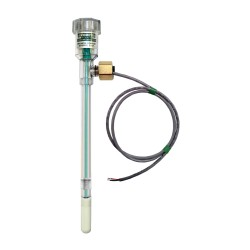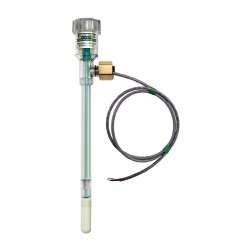
Watermark 200SS Granular Matrix Soil Moisture Sensor
Advanced granular matrix sensor for measuring soil moisture tension. Ideal for precision irrigation management, agriculture, and landscape monitoring.
Product Highlights
View all in Specifications tabOverview
The Watermark 200SS is a solid-state granular matrix soil moisture sensor that measures soil water tension (also called soil moisture tension or soil suction). This proven technology provides reliable, maintenance-free soil moisture monitoring for precision irrigation management, agricultural research, and landscape water conservation.
Key Features
- Solid-State Technology: No liquid to freeze or boil, works in all climates
- Wide Range: Measures 0-200 centibars (0-200 kPa) of soil water tension
- Maintenance-Free: No servicing required once installed
- Temperature Compensated: Accurate readings across wide temperature range
- Durable Construction: Stainless steel body for long-term field use
- Low Cost: Economical solution for multi-point monitoring
- Easy Installation: Simple burial at desired depth
- Proven Reliability: Widely used worldwide for over 30 years
Applications
- Precision irrigation scheduling
- Crop water stress monitoring
- Turfgrass and landscape irrigation
- Greenhouse growing systems
- Agricultural research
- Water conservation programs
- Drought management
- Soil moisture profiling
- Root zone monitoring
- Irrigation system automation
Technical Specifications
The Watermark 200SS uses electrical resistance between two concentric electrodes embedded in a granular matrix material. As the matrix exchanges water with the surrounding soil, its electrical resistance changes in correlation with soil water tension. The sensor operates from 0 to 200 centibars, covering the range most important for plant-available water.
Understanding Soil Water Tension
Soil water tension (measured in centibars or kilopascals) indicates how tightly water is held in the soil:
Soil Moisture Ranges
- 0-10 cb: Saturated soil, excess water
- 10-30 cb: Field capacity, ideal moisture for most crops
- 30-60 cb: Adequate moisture, good for irrigation management
- 60-100 cb: Beginning of stress for sensitive crops
- 100-150 cb: Moderate water stress
- 150-200 cb: High water stress, irrigation critical
Irrigation Management
The Watermark sensor helps determine optimal irrigation timing:
- Monitor soil drying between irrigations
- Trigger irrigation at appropriate tension levels
- Prevent over-watering and under-watering
- Optimize water use efficiency
- Reduce water costs and nutrient leaching
Installation Guidelines
Depth Placement
- Shallow root crops: 15-30 cm (6-12 inches)
- Deep root crops: 30-60 cm (12-24 inches)
- Multi-depth monitoring: Install sensors at multiple depths for complete profile
- Active root zone: Place sensors in primary water uptake zone
Installation Steps
- Auger hole to desired depth
- Place sensor at bottom of hole
- Fill hole with native soil, tamping firmly
- Mark location and protect wire
- Allow 24-48 hours for soil contact equilibration
- Begin monitoring readings
Site Selection
- Install in representative areas of field
- Avoid low spots or anomalies
- Keep away from irrigation emitters (30+ cm)
- Multiple sensors provide better field average
Reading and Interpretation
Using a Watermark Meter
The sensor requires a Watermark meter or datalogger to read resistance values and convert to centibars. Readings should be taken regularly:
- Daily: During critical growth stages
- Every 2-3 days: During active growing season
- Weekly: During dormant periods
- Before and after irrigation: To verify water application
Irrigation Thresholds by Crop
Vegetables (sensitive)
- Trigger: 30-40 cb
- Stress: 50+ cb
Field Crops (moderate)
- Trigger: 50-70 cb
- Stress: 100+ cb
Orchards & Vineyards
- Trigger: 60-80 cb
- Stress: 120+ cb
Turfgrass
- Trigger: 50-80 cb
- Stress: 100+ cb
Advantages Over Other Methods
vs. Volumetric Sensors (Capacitance/TDR)
- More relevant: Measures water availability to plants, not just water content
- Soil type independent: Works in all soil types without calibration
- Lower cost: Economical for multiple monitoring points
- Less sensitive to salts: Not affected by soil salinity
vs. Traditional Tensiometers
- No maintenance: No refilling or servicing required
- Wider range: Measures beyond 80 cb limit of tensiometers
- No freezing issues: Works in freezing conditions
- No vacuum loss: Solid-state, no leaking or air entry
Connectivity and Data Logging
The Watermark 200SS connects to:
- Watermark Meters: Handheld readers for manual readings
- Data Loggers: Automated continuous monitoring
- Wireless Systems: IoT platforms for remote monitoring
- Irrigation Controllers: Direct integration for automated irrigation
- Cloud Platforms: Real-time data access and alerts
Maintenance and Lifespan
Maintenance Requirements
- None required: Maintenance-free operation
- Periodic checks: Verify wire connections and sensor location markers
- No calibration: Factory calibrated, no field calibration needed
Expected Lifespan
- Typical: 5+ years of reliable operation
- Factors affecting lifespan:
- Installation quality (good soil contact)
- Soil chemistry (highly corrosive soils may reduce life)
- Physical damage (tillage, rodents, lightning)
- Wire protection
Troubleshooting
- No reading: Check wire connections, sensor may be damaged
- Erratic readings: Poor soil contact, allow more equilibration time
- Very high resistance: Sensor may be too dry or damaged
- Very low resistance: Sensor may be saturated or damaged
Temperature Compensation
The Watermark 200SS includes temperature compensation in the sensor design. For best accuracy, soil temperature should be measured alongside resistance and used with conversion tables or software that applies temperature compensation algorithms.
Water Conservation Benefits
Using Watermark sensors for irrigation management provides:
- 30-50% water savings: Avoid over-irrigation
- Improved crop quality: Optimal water stress management
- Reduced costs: Lower water, pumping, and fertilizer costs
- Environmental protection: Less runoff and deep percolation
- Regulatory compliance: Meet water use restrictions
- Drought resilience: Maximize efficiency during water scarcity
Research Applications
The Watermark sensor is widely used in:
- Crop water requirement studies
- Irrigation efficiency research
- Drought tolerance breeding programs
- Climate change adaptation research
- Precision agriculture development
- Soil physics studies
Integration with Smart Irrigation
Modern irrigation systems integrate Watermark sensors for:
- Automated irrigation: Direct control of valves and pumps
- Mobile alerts: Notifications when irrigation needed
- Remote monitoring: Check soil moisture from anywhere
- Historical tracking: Analyze trends over seasons
- Multi-site management: Monitor multiple fields or zones
- Weather integration: Combine with ET and rainfall data
Related Products
Other solutions in the soil category


